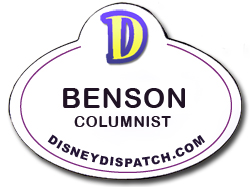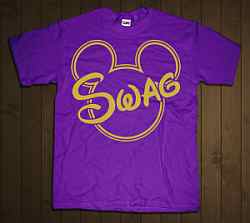FROM: It's All in a Nametag Published Thursdays
Song of the Splash Mountain
"Hush, child!" That's the typical response when you mention 'Song of the South' to a Disney Cast Member. So how does Disney square one of its most popular attractions, Splash Mountain, with a film it would like to forget? Tough one...
Splash Mountain is one of the most popular attractions at Disneyland and Walt Disney World. At the time it was built, it was one of the most expensive attractions ever created, costing almost $75 million. The westernmost area of Disneyland, Bear Country, was often nearly empty in the late afternoon, and so it was decided that a new attraction was needed to bring guests to the area.
When Splash Mountain opened in 1989, a lavish press event was held (and what press event would be complete without special nametags given to Cast Members and press?).
The perennial Sunday night television program, The Wonderful World of Disney, even broadcast a special episode entitled "Ernest Goes to Splash Mountain". It starred Jim Varney as his alter ego Ernest P. Worrell, the first human test pilot to venture into the depths of the new attraction.
Splash Mountain at Disneyland
Nametag worn at press event for grand opening of Disney World's Splash Mountain
The title card for "Ernest Goes to Splash Mountain"
Some of the America Sings characters
The Splash Mountain finale
James Baskett as Uncle Remus
The cast of Song of the South
Walt Disney, Luana Patton, and Bobby Driscoll look at Song of the South story boards
Source of Splash
The theme of Splash Mountain was taken from the 1946 Disney film Song of the South. You are probably familiar with many of the characters from the film: Brer Fox, Brer Bear, Brer Rabbit, and so on. They are all in Splash Mountain as wonderfully detailed audio animatronic figures. In fact, here's a bit of Disneyland trivia you might not know.
In 1988, the attraction America Sings, over in Disneyland's Tomorrowland, closed after fourteen years in operation. America Sings was a musical presentation of America's musical history, told by a zany menagerie of audio-animatronic animals.
Someone had the wonderful idea that a few of these animals could be used in the new Splash Mountain attraction. Once the main scenes were populated, there were still many figures left over. So another idea was to simply create a grand finale musical number for Splash Mountain, and place the remaining characters in it.
If you've ridden Splash Mountain, you've probably heard references to a man called Uncle Remus. Who is he? Not a real person, but rather the fictional narrator in a series of African-American folk tales that were compiled and published by the American author Joel Chandler Harris.
Where's the Respect for Uncle Remus?
Walt Disney was quite fond of the Uncle Remus stories, and in 1946 adapted some of them for Song of the South. In a 1946 promotional radio program, Walt Disney said of the Uncle Remus stories: "I first heard the stories of Uncle Remus when I was a boy down in Missouri. Since then, they've been among my favorites. I believe no folk stories have been better loved than the Joel Chandler Harris tales of Uncle Remus. I've always wanted to do a picture of them."
Walt Disney eventually cast James Baskett in the role of Uncle Remus. Baskett was born in 1904 in Indianapolis, Indiana, and after leaving college moved to New York City to pursue an acting career. He found some small roles in films, and was a regular member of the Amos and Andy radio program for several years. Baskett brought a lovable and charismatic performance to the role of Uncle Remus, and in 1947 he was honored by the Academy of Motion Picture Arts and Sciences with a special Oscar "for his able and heart-warming characterization of Uncle Remus, friend and story teller to the children of the world in Walt Disney's Song of the South."
James Baskett was the first African-American male actor to receive an Oscar, or Academy Award as it is properly known. He was not the only Oscar winner to grace the cast of Song of the South. Hattie McDaniel, who played Tempy in the film, won an Oscar for her performance in the 1939 film Gone with the Wind.
Song of the South was an innovative film, combining live-action human actors interacting with animated characters in the same frame of film. (Baskett also provided the voice of one of the animated characters, Brer Fox.) The film was a financial success for the Walt Disney Company, and was re-released into theaters many times in succeeding decades.
When the home video market exploded in the late 1970's, the Disney Company was quick to jump aboard the band wagon. The rich legacy of Disney films was released on many forms of media over the years, including video cassette, laserdisc, DVD, and Blu-ray.
And yet, for some reason, other than a small laserdisc release in Asia and a VHS release in England, Song of the South has not been released on any of the previously mentioned formats in the United States and the rest of the world.
Why?
Brer Baloney
I have never been able to find a good answer. Could it be that Disney considers Song of the South politically incorrect? Could it be that Uncle Remus doesn't click with today's audiences? I don't think those are the answers, considering other material that Disney has produced.
Take, for example, the release of the World War II-era propaganda cartoons that were included in Walt Disney Treasures: On The Front Lines DVD set. The cartoons caricatured Axis leaders like Japanese Prime Minister Hideki Tojo, Italian dictator Benito Mussolini, and Adolf Hitler. And yet, even though these cartoons are today viewed as 'politically incorrect' and 'culturally insensitive', Disney saw them fit enough to be released on DVD, albeit with an introduction and disclaimer by film critic Leonard Maltin.
What, then, is so wrong about Song of the South that keeps the Walt Disney Company from releasing it onto home video?
Elements of the film are apparently good enough to use in other places. As we examined in the first part of this column, the animated characters from the film were adapted into the Splash Mountain attraction at the various Disney resorts around the world. Zip-A-Dee-Doo-Dah, the song that James Baskett sings, is one of the most famous Disney songs of all time, and has been recorded by scores of other artists.
But why does the film itself still not have an official release? Disney has largely remained silent about it. Since the last theatrical release in 1986, Song of the South has been quietly buried by Disney.
James Baskett was one of the first live actors hired by Walt Disney, who spared no expense and created many new special effects processes to bring Uncle Remus to the screen. I would love to see Disney completely restore Song of the South, as has been done with other films, and release it on DVD and Blu-ray. Leonard Maltin could again be called upon to introduce it, as he has done on many other Disney films.
Releasing Song of the South would not only honor the legacy of James Baskett, but also the work and dedication of all those who brought the film to life.
More: IT'S ALL IN A NAMETAG
Stuff Not to Skip
- Benson Myers's Blog
http://mousebadges.blogspot.com/2010/12/disney-store.html - Benson Myers's Nametag Museum
http://www.nametagmuseum.com







